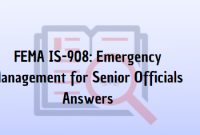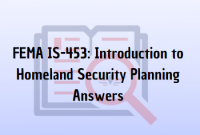IS-246.22: Implementing the Federal Priorities and Allocations System or FPAS is the name of a FEMA course that describes certain producers for using Federal Priorities and Allocations System or FPAS priority ratings for contracts and orders that support FEMA programs.
The course called IS-246.22: Implementing the Federal Priorities and Allocations System (FPAS) should be taken by FPAS Officers – FEMA personnel who are designated by FEMA management to fulfill FPAS Officer functions. In addition, it is also recommended for every program official that is responsible for directing the placement of FPAS-related orders and making FEMA program and procurement policy and decisions; all Contracting Officers/Specialists who will be primary points of contract with prime contractors on FPAS issues and those who may be responsible for determining FPAS activity eligibility; and anyone who is interested in getting know more about FPAS.

After completing the course, all participants will have to take a test related to the course. The test usually consists of a number of questions. To be able to get the best result, learn all the questions that may appear in the test below. Make sure to check the correct answers in red.
1. Who directs the use of priority ratings in support of DPAS Approved Programs?
A. Contracting Officers/Specialists.
B. DPAS Officers of component organizations.
C. Contracting Officer’s Technical Representatives.
D. FEMA program officials/heads of components.
2. Which of the following items or services are generally eligible for DPAS support?
A. Cots and blankets to help house survivors at a shelter during a declared emergency or disaster.
B. An employment contract with an engineering specialist.
C. Flashlights that are readily available at home improvement stores in the area.
D. Desks, chairs, and filing cabinets for a Disaster Recovery Center.
3. With assistance from the DPAS Officer, Form BIS-999, Request for Special Priorities Assistance, should be completed by:
A. The person with the most information about the problem.
B. A Department of Commerce employee.
C. The Director, Office of Policy and Program Analysis.
D. A member of the Joint Field Office command staff.
4. If a DPAS problem is identified, the DPAS Officer first:
A. Cancels the rated order and documents the reason(s) in the contract file.
B. Gathers information from those involved with the rated order (government and/or private sector).
C. Suspends the rated order by issuing a certified letter to all parties in the supply chain.
D. Notifies the FEMA Administrator that a DPAS rated order is in jeopardy.
5. The DPAS Officer must coordinate with the Contracting Officer’s Technical Representative before contacting the:
A. FEMA program official/head of the component.
B. Prime contractor.
C. Office of Policy and Program Analysis.
D. Lead DPAS Officer.
6. DPAS priority ratings may be used for “industrial resources,” which include:
A. Civil transportation.
B. Bottled water.
C. Construction materials for a construction project.
D. Health supplies.
7. The DPAS Officer should promptly forward any unresolved questions or requests for Special Priorities Assistance to the:
A. Program official/head of the component.
B. Department of Commerce.
C. Lead DPAS Officer.
D. FEMA Administrator.
8. Who typically resolves problems or issues that arise after a DPAS rated order has been placed?
A. Finance and Administration Section Chief
B. FEMA Administrator
C. Office of General Counsel
D. DPAS Officer
9. The most commonly used DPAS priority rating for FEMA programs is DO-N1, which applies to:
A. Domestic counter-terrorism, including law enforcement.
B. Federal emergency preparedness, response, and recovery activities.
C. Critical infrastructure protection and restoration programs.
D. State, local, and tribal government emergency preparedness, response, and recovery.
10. The four required elements of a DPAS rated order are the priority rating, contract clause, signature of the Contracting Officer/Specialist, and the delivery or performance date. That date must:
A. End no more than 15 days from the date of contract issuance.
B. Allow for flexibility (e.g., “as needed for program requirements”).
C. Be specific (e.g., a month, day, and year).
D. Indicate the urgency of the situation (e.g., “immediately”).
11. The prime contractor is generally required to take all of the following actions, EXCEPT:
A. Place rated orders with any subcontractors or suppliers.
B. Accept a rated order if the contractor normally produces the item for sale.
C. Provide preferential scheduling, as needed to achieve timely delivery.
D. Fulfill FEMA’s rated orders before any other rated orders.
12. To acquire items or services with a rated order that fall outside DPAS jurisdiction over “industrial resources,” coordination is required through the:
A. Prime contractor and the supply chain.
B. FEMA Administrator.
C. Department of Homeland Security.
D. Office of Policy and Program Analysis.
13. Which document contains guidance and procedures for the use of DPAS priority ratings in support of FEMA programs?
A. FEMA DPAS Manual.
B. Defense Production Act of 1950.
C. Executive Order 13603.
D. DHS Delegation 9001.1.
14. DPAS Officers should engage in the following activities as required, EXCEPT:
A. Authorize use of DPAS priority ratings to support acquisition of items in a declared emergency or disaster.
B. Assist in the development and submission of requests for DPAS priority rating authority.
C. Review and validate a request for SPA to determine if it complies with DPAS criteria,
D. Provide information and training about use of DPAS in support of FEMA programs.
15. Which of the following conditions is required before a DPAS priority rating may be used in contracts and orders?
A. The contractor anticipates or reports a delivery or performance problem.
B. The President has signed an emergency or disaster declaration under the Stafford Act.
C. The DPAS Officer completes Form BIS-999, Request for Special Priorities Assistance.
D. The program and acquisition activity are both deemed eligible for DPAS support.
16. Based on the direction of FEMA program officials, who places DPAS rated orders?
A. Prime contractors and subcontractors.
B. Any FEMA employee.
C. Contracting Officers/Specialists.
D. The Lead DPAS Officer.
17. Special Priorities Assistance is required:
A. When a DPAS problem cannot be easily resolved in a timely manner.
B. Prior to the release of any solicitation.
C. If the contract or order is initiated at the Headquarters level.
D. For every contract or order with a DPAS priority rating.
18. The FEMA program official is required to submit a report to the Office of Policy and Program Analysis on the use of DPAS priority ratings. This report must be submitted:
A. Annually
B. Daily
C. Quarterly
D. Weekly
19. An item is considered “common use” if it is commercially available, used off-the-shelf without modification, AND:
A. Shared by several FEMA facilities after the same disaster.
B. Available in sufficient quantity for program requirements.
C. Inexpensive enough to be acquired with a FEMA purchase card.
D. Produced locally to support the economy of the affected area.
20. If a contractor cannot deliver items in the requested timeframe and rejects a rated order, the contractor must:
A. Locate an alternate contractor to fulfill the rated order.
B. Offer the earliest possible delivery date(s).
C. Abstain from bidding on FEMA contracts for 90 days.
D. Expand the plant to prevent future rejected rated orders.






